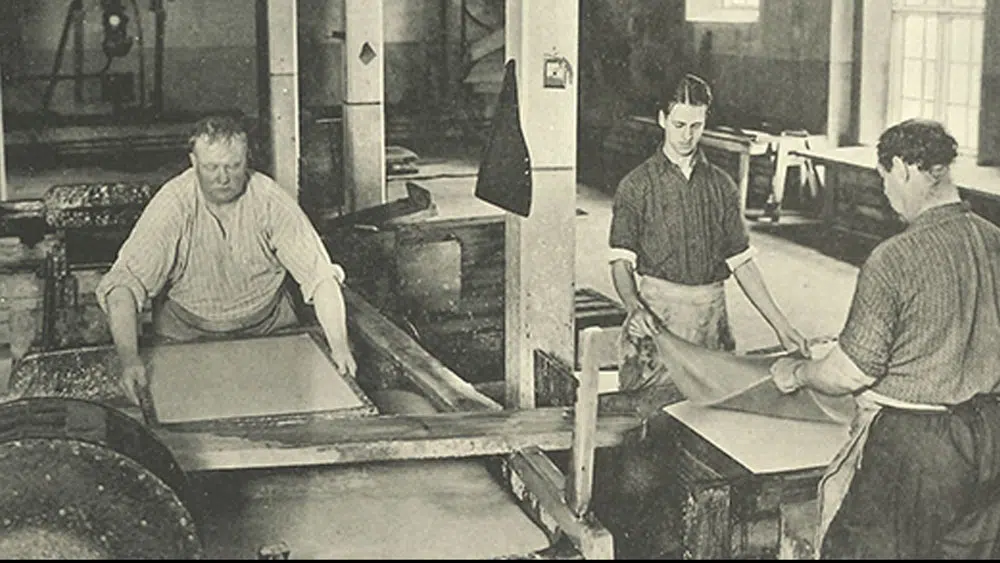History
We have produced paper for more than 300 years. The art of paper production is a fine old tradition which is upheld by our skilled team members.
The history started in 1658…
Lessebo Mill is located in a densely forested area right between large shallow lakes in the inland region of Småland. It is an area characterised by small-scale farming and the traces it has left behind. It is also an area with a long and diverse history of production. As early as 2000 years ago, people utilised the forest and the iron-rich lakes to produce iron. In 1662, Lessebo Mill started as an iron mill, utilising wood, iron, and hydropower, which was the first industrial operation in the area.
Slowly over the years, paper took over as the main product. When paper production started in 1693, the first and most important customer was the newly established naval base in Karlskrona.
This was a long time ago, and today Lessebo Paper is a mill with complete focus on forest-based products with a modern product mix of graphical papers.

Workers in front of the hand paper mill, circa 1927.
Erik Knutsson bought land between the Lake Läen and the Lake Öjen to build and start an iron mill.


Lessebo Mill started as an iron mill, utilizing wood, iron ore from Läen, and hydropower. The production of cast iron was the first industrial operation in the area.

Stamp used to mark products from Lessebo iron mill.

Stamp used to mark products from Lessebo iron mill.
Slowly over the years, handmade paper took over as the main product. The primary customer Lessebo had was the newly established naval base in Karlskrona.

Workers at the hand paper mill in 1934, a process that has been the same since 1693.

Workers at the hand paper mill in 1934, a process that has been the same since 1693.
Lessebo Mill received permission to produce and sell paper from the Swedish National Board of Trade. The naval base in Karlskrona guaranteed that the quality of the paper maintained a high standard.
Johan Lorens Aschan was the owner of Lessebo Mill from 1802 to 1856. Aschan made a great impact on Lessebo during his time as an owner by arranging healthcare and education for all the employees at Lessebo iron and paper mill and the adjacent businesses.


The owner of Lessebo iron and paper mill at that time, Johan Lorentz Aschan, bought Lessebo’s first paper machine from England.

Lessebo mill circa 1840.

Lessebo mill circa 1840.
Lessebo Paper Mill invested in the construction of the railway system in the south of Sweden. The investment made it possible to influence the railways’ route, and Lessebo got a railway station.
Lessebo Mill stopped the production of iron, and paper production became our core business.
A decision was made to build and start an integrated pulp mill. The pulp mill was taken into action a few years later. Today, the pulp we use in our production is sourced from a local pulp mill.
Lessebo Paper received its first FSC Certificate.

Lessebo Paper Mill invested in two new sheet cutters, one optimized for cut-size formats and one optimized for folio sizes. A ream wrapping machine and a pallet wrapping machine were also acquired. The investment also included a new warehouse.
Lessebo Paper is celebrating 300 years of commercial paper production.
Lessebo Recycled is certified according to the EU Ecolabel.

Lessebo Paper received Cradle to Cradle Certified® at the Gold level for their white paper ranges of Lessebo Design and Scandia 2000. Lessebo Paper is the first paper mill in the world to reach the gold level.
Lessebo Paper is a member of the Paper Profile, a uniform declaration for presenting environmental product information. Paper Profile enables the professional pulp, paper, and paperboard buyer to make well-informed product choices.

Lessebo Paper is part of the Book Chain Project, an international and pioneering initiative aimed at promoting sustainability within the publishing industry.
